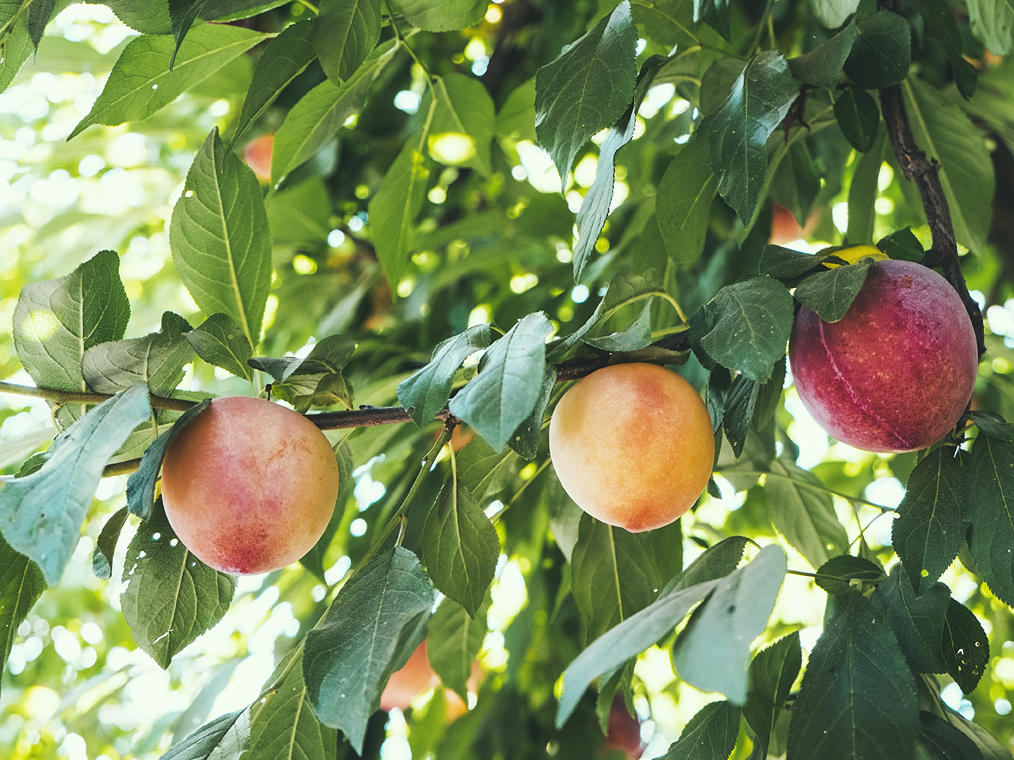
Q&A with Ann Ralph: Keeping Fruit Trees Small

It’s bare-root planting time, and our January issue features the latest and greatest in hybrid deciduous stone fruits (peaches, plums, pluerries—that’s right—plum-cherry crosses). When Phil Pursel of Dave Wilson Nursery came to the Test Garden to help us plant a few trees of our own, he did something I’d never seen before—he chopped each baby tree right after planting it. I mean HACKED each one down to about knee height. I winced. I gasped. I thought he was out of his mind.
Turns out that the pruning cut that hurt my soul (technical term: heading cut) is the best possible thing you can do to keep your fruit tree small and shapely.
Fresh off the press is Ann Ralph’s new book Grow a Little Fruit Tree (Storey Publishing, 2014; $17). Anne spent years being the fruit tree specialist at nurseries (including at Berkeley Hort for 12 years), and her book is beautiful, technical, and totally approachable. While the book and the technique get the teeny tiniest of mentions in our print edition, I wanted to expound a bit more here. You’ve got to do this when you first plant a new tree if you want to keep fruit within reach.
Why doesn’t anyone know about this technique?
Ann Ralph: Orchards have been pruned this way for a hundred years. Every time you drive past and orchard and you see all of the trees branching at the exact same low height, the trees have been cut this way! But it seems that this information is just a sentence in every book, and people breeze right past it. It just hasn’t made the jump to backyard orchard keeping.
Why is it so important to make this cut?
Ann: A heading cut allows you to keep the tree as tall as you are! You’ll keep fruit within reach (for easy harvest), and you can also do your subsequent twice yearly pruning without a ladder. It works by removing the growing tip and forcing all the side buds to grow.
Why don’t trees come pre-cut?
Ann: It’s hard for professionals to make that cut. It’s emotionally difficult. It’s a cut that no one wants to make unless you’re growing your own trees and you really understand the consequences. Also, maybe some people want a super large tree for shade. And lastly, don’t you think all of those stubby trees would just look horrifying in the nursery?
Should heading cuts be made on every type of fruit tree?
Ann: Make heading cuts on deciduous fruit trees—plums, peaches, apples, etc.
Can you grow these fruit trees in containers and head them to keep them small?
Ann: No! You can’t. You really can’t. The thing about this technique is that the trees develop a fabulous root system that just doesn’t translate to a container. If you want to grow fruit in a pot, you’re best options are citrus or figs.
Do you have an absolute favorite variety?
Ann: Flavor preference is so individual, but ‘Arctic Glo’ nectarine is the one I absolutely had to plant. It’s the fruit of fruit; it has the perfect balance of sweet of tart. It has disadvantages, namely, a cling pit, meaning it doesn’t come easily apart. But it’s heaven to eat. I put up with its pit.
Best advice for someone with a messed-up tree?
Ann: Well, the only opportunity to make the crucial heading cut is the first year. You can always do corrective pruning and make things better, but you can never get a lovely little tree if you don’t do this when it goes in the ground. If you have a tree that needs some work, your best bet is to go back to your favorite local nursery and ask. They know the community and can recommend someone great.





